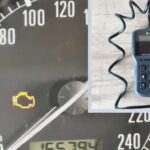If you’re just starting out with car diagnostics and own a Ford, Lincoln, Mercury, or Mazda vehicle, you’ve likely heard of FORScan. This powerful software allows you to delve deep into your car’s systems for diagnostics, modifications, and more. To use FORScan on your Windows laptop, you’ll need an OBD2 USB adapter, and the ELM327 is a popular, budget-friendly option. This guide will walk you through setting up FORScan with an ELM327 OBD2 USB adapter on Windows, perfect for rookies getting their hands dirty with automotive diagnostics.
Before we dive in, a word of caution: using cheap clone ELM327 adapters carries risks. Incorrectly switching between HS (High Speed) and MS (Medium Speed) CAN buses, especially with adapters that have a manual switch, can potentially lead to module corruption. Always be mindful when operating the switch and ensure you understand when and why to use each setting. Communication interruptions during write processes can also brick modules. Proceed with caution and at your own risk. It’s highly recommended to read this entire guide before you begin to understand the process and potential pitfalls.
This guide is designed to simplify the initial setup and connection process. It focuses on the practical steps to get you connected to your Ford vehicle using FORScan and a budget ELM327 adapter. Don’t expect in-depth troubleshooting advice here; instead, we’ll concentrate on getting your system up and running smoothly.
First, let’s gather the necessary equipment. You’ll need a physical interface to bridge the gap between your car’s OBDII port and your Windows PC. This is where the ELM327 adapter comes in. While there are Bluetooth options, a wired USB connection is generally recommended for stability and reliability, especially when you’re just starting out. The “ELM327” term has become somewhat generic, referring to a specific chip and its clones. Many of these clones work effectively, and for this guide, we’ll focus on a commonly used type.
The adapter used in this guide is the “OHP ELMconfig FORScan OBD2 USB Cable | Full ELM327 Diagnostic Programming Tool”. While this specific adapter has worked with FORScan v2.3.50 (as of January 2023), FORScan officially recommends certain adapters for optimal performance and safety. You can find a list of recommended adapters on the FORScan website. Using a recommended adapter is generally advised for trouble-free operation, as FORScan may issue warnings about unsupported adapters upon startup.
Let’s get started with the setup process. These instructions are tailored for the OHP ELMconfig FORScan adapter mentioned above. If you’re using a different adapter, driver installation steps might vary.
For the OHP ELMconfig ELM327 adapter, you’ll find a user guide titled “INTRODUCTION TO ELM327 USB MODIFIED DEVICE“. Driver installation instructions are available at “Installation Guides/“, and the required Virtual COM Port (VCP) driver can be downloaded from “Virtual COM Port Drivers“. You only need the VCP driver for this setup.
First, download the VCP driver. The FTDI website offers several download options, but you’ll specifically need the VCP driver. Download, extract the ZIP file, and run the driver installer as administrator. Do not plug in your ELM327 adapter into your computer yet.
Next, download and install FORScan for Windows from the official website: FORScan for Windows. Install the software but do not launch it yet. The adapter needs to be connected and recognized by your Windows system before starting FORScan.
Now, connect the USB end of your ELM327 adapter to your Windows laptop. After plugging it in, open Device Manager to verify that the ELM adapter is recognized and listed. It should typically appear under “Ports (COM & LPT)” or “Universal Serial Bus controllers.”
Once the adapter is recognized by your computer, plug the OBD2 end of the ELM327 adapter into the OBDII port in your car. Ensure your vehicle’s ignition is turned off during this step. Locate your OBDII port – it’s typically located under the dashboard on the driver’s side.
Before proceeding, make sure the HS/MS switch on your ELM327 adapter is set to “HS” (High Speed). Forgetting this step is a common mistake and will prevent FORScan from connecting to your car initially.
Now, turn your car’s ignition to the “ON” position (engine off). Launch the FORScan application on your Windows laptop. When FORScan starts, it may display a warning message if it detects an unsupported adapter. Acknowledge any prompts, ensure the ignition is on as instructed, and click “OK.”
In the bottom-left corner of the FORScan window, click the “Connect” button (usually represented by a car icon and a plug).
FORScan will then communicate with your vehicle and may prompt you to select your vehicle’s model year. Once the initial connection is established, FORScan will start reading data from various modules in your car.
If you’re using an ELM327 adapter with a manual HS/MS switch, FORScan will eventually display a pop-up message instructing you to switch from HS mode to MS mode.
Physically toggle the switch on your ELM327 adapter to “MS,” then click “Yes” in the FORScan prompt, and “OK” on any subsequent pop-up messages. FORScan will then continue reading the remaining modules in your vehicle.
This guide covers the essential steps to get you connected to your Ford vehicle using FORScan and an ELM327 OBD2 USB adapter on Windows. Exploring the full capabilities of FORScan is a separate learning journey. For detailed information on using FORScan’s features, refer to the FORScan Forums.
Remember, as a beginner, it’s crucial to exercise caution when using FORScan. This software has the power to make significant changes to your vehicle’s systems. Incorrect modifications can lead to serious issues. Start by familiarizing yourself with data reading and monitoring PIDs before attempting any configuration changes. FORScan is a powerful tool, but it’s not a place for experimentation without proper understanding. Proceed cautiously, and always research thoroughly before making any changes to your vehicle’s settings.
